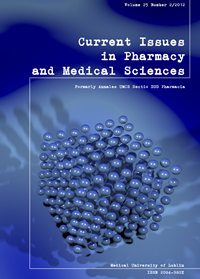The role of glycosaminoglycans and proteoglycans in atherosclerosis
DOI:
https://doi.org/10.12923/j.2084-980X/25.2/a.22Keywords:
atherosclerosis, glycosaminoglycans, proteoglycans, lipoproteins, heparan sulfateAbstract
Numerous studies point out to the role of glycosaminoglycans (GAG) and proteoglycans (PG) in the pathogenesis of atherosclerosis. Both GAG and PG take part in the formation of tunica intima and tunica media, contribute to the neointima formation, and can be found in the glycocalix layer. These molecules influence many properties of blood vessels, such as permeability, viscoelasticity, hemostasis, lipid metabolism, and extracellular matrix organization. The PG from atherosclerotic arteries had higher binding affinity for LDL, which suggests that alterations in the vascular PG contents predispose to atherosclerosis development. Atherogenic LP retained in the intima in association with GAG/PG, undergo several modifications, such as the oxidation or aggregation. LDL exposed to CS PG is more susceptible to such modification, which favours uptake by the macrophages. Moreover, oxy-LDL stimulated SMC to synthesize longer chains GAG and enhanced LDL binding properties. For this reason GAG structure and metabolism are the potential targets of the therapeutic investigation.
References
1. Ballinger M. L. et al.: Regulation of glycosaminoglycan structure and atherogenesis. Cell Mol Life Sci., 61, 1296, 2004.
2. Bancells C. et al.: High binding affinity of electronegative LDL to human aortic proteoglycans depends on its aggregation level. J. Lipid Res., 50, 446, 2009.
3. Bancells C. et al.: Immunochemical Analysis of the Electronegative LDL Subfraction Shows That Abnormal N-terminal Apolipoprotein B Conformation Is Involved in Increased Binding to Proteoglycans. J. Biol. Chem., 14, 1125, 2011.
4. Bishop J. R., Schuksz M., Esko J.D.: Heparan sulphate proteoglycans fine-tune mammalian in physiology. Nature, 446, 1030, 2007.
5. Flood Ch. et al.: Molecular Mechanism for Changes in Proteoglycan Binding on Compositional Changes of the Core and the Surface of Low-Density Lipoprotein–Containing Human Apolipoprotein B100. Arteioscler Thromb Vasc Biol, 24, 564, 2004.
6. Fuki I.V., Iozzo R.V., Williams K.J.: Perlecan heparan sulfate proteoglycan: a novel receptor that mediates a distinct pathway for ligand catabolism. J. Biol. Chem., 275, 25742, 2000.
7. Hooper NM.: Glypican-1 facilitates prion conversion in lipid rafts. J Neurochem. 116, 721, 2011.
8. Karangelis DE: Glycosaminoglycans as key molecules in atherosclerosis: the role of versican and hyaluronan. Curr Med Chem., 17, 4018, 2010.
9. Kolset S.O., Salmivirta M.: Cell surface heparan sulfate proteoglycans andlipoprotein metabolism. Cellular and molecular life sciences, 56, 857, 1999.
10. Lähdesmäki K. et al.: Acidity and lipolysis by group V secreted phospholipase A(2) strongly increase the binding of apoB-100-containing lipoproteins to human aortic proteoglycans. Biochim Biophys Acta., 1821, 257, 2012.
11. Leta G.C., Mourao P.A.S., Tovar A.: Human venous and arterial glycosaminoglycans have similar affinity for plasma low-density lipoproteins. Biochim Biophys Acta, 1586, 243, 2002.
12. Lewis J.E., Xu X.: Abnormal Glomerular Permeability Characteristics in Diabetic Nephropathy. Diabetes Care, 31, 202, 2008.
13. Malavaki Ch. J. et al.: Heparan sulfate: biological significance, tools for biochemical analysis and structural characterization. Biomed. Chromatogr., 25, 11, 2011.
14. Nakashima Y., Wight T.N., Sueishi K.: Early atheroslcerosis in humas: role of diffuse intimal thickening and extracellular matrix proteoglycans. Cardiovascular research, 79, 14, 2008.
15. Pillarisetti S.: Lipoprotein modulation of subendothelial heparan sulfate proteoglycans (perlecan) and atherogenicity. Trends in Cardiovascular Medicine, 10, 60, 2000.
16. Segev A., Nili N., Strauss B.H.: The role of perlecan in arterial injury and angiogenesis. Cardiovascular Research, 63, 603, 2004.
17. Tannock L.R., King V.L.: Proteoglycan mediated lipoprotein retention: A mechanism of diabetic atherosclerosis. Reviews in Endocrine & Metabolic Disorders, 9, 289, 2008.
18. Tarbell J. M. Tarbell: Shear stress and the endothelial transport barrier, Cardiovasc Res. 87, 320, 2010.
19. Tovar A.M.F. et al.: Age-related changes in populations of aortic glycosaminoglycans: species with low affinity for plasma low-density lipoproteins, and not species with high affinity, are preferentially affected. Arteriosclerosis, thrombosis and vascular biology, 18, 604, 1998.
20. Tran-Lundmark K. et al.: Heparan sulfate in perlecan promotes mouse atherosclerosis: roles in lipid permeability, lipid retention and smooth muscle cell proliferation. Circ Res, 103, 43, 2008.
Downloads
Published
Issue
Section
License
Copyright (c) 2012 Authors

This work is licensed under a Creative Commons Attribution-NonCommercial-NoDerivatives 3.0 Unported License.


